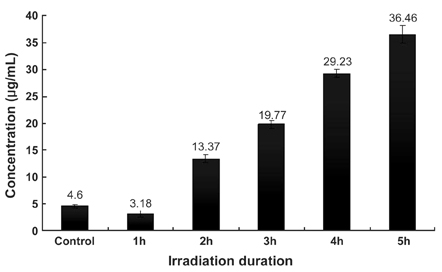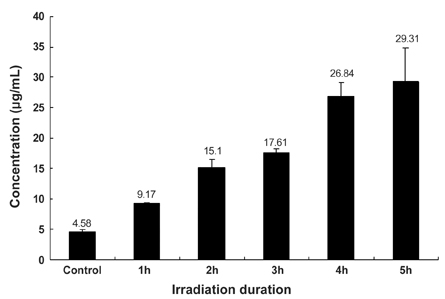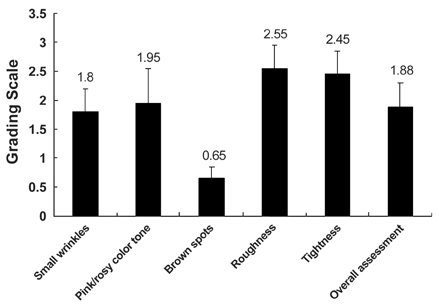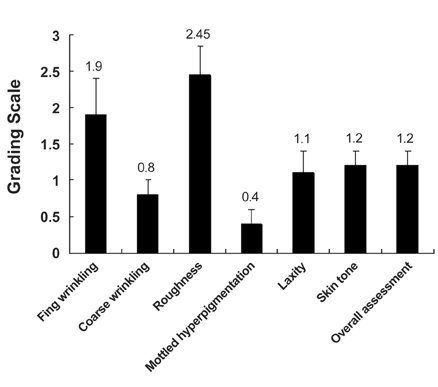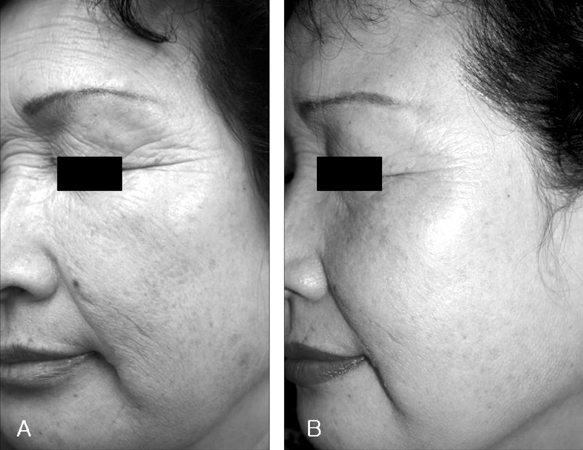Yonsei Med J.
2006 Aug;47(4):485-490. 10.3349/ymj.2006.47.4.485.
Effects of Infrared Radiation on Skin Photo-Aging and Pigmentation
- Affiliations
-
- 1Department of Dermatology and Cutaneous Biology Research Institute, Yonsei University College of Medicine, Seoul, Korea. kwanglee@yumc.yonsei.ac.kr
- KMID: 1779497
- DOI: http://doi.org/10.3349/ymj.2006.47.4.485
Abstract
- Infrared radiation is increasingly and uncritically used for cosmetic and wellness purposes, despite the poorly understood biologic effects of such treatments on humans. In the present study, we investigated the effects of infrared radiation on collagen and elastin production in dermal fibroblasts, as well as the clinical and histopathologic effects of infrared radiation on photo-aged facial skin lesions. In order to determine the effects of infrared radiation on collagen and elastin production, dermal fibroblasts were exposed to infrared radiation for varying lengths of time and collagen and elastin contents were subsequently determined. Additionally, 20 patients with mild to moderate facial wrinkles and hyperpigmented lesions received daily treatments of far infrared radiation (900 to 1000micronm) for six-months. During the treatment, patients and a medical observer conducted independent photographic and clinical evaluations every 4 weeks, and skin biopsies were obtained for histological analysis at baseline and one month post-treatment. We found that the content of collagen and elastin produced by the fibroblasts increased after infrared radiation, and that this increase was proportional to the duration of irradiation exposure. Following 6 months of treatment, all patients reported good (51-75%) improvements in skin texture and roughness. Additionally, patients noted fair (25-50%) improvement in color tone of the skin; however, improvements in hyperpigmented lesions were not observed. Objective medical evaluation of the patients indicated that roughness and laxity were fairly improved, but there was no significant improvement in hyperpigmented lesions. Histological examination failed to reveal any differences as well. These results suggest that infrared radiation may have beneficial effects on skin texture and wrinkles by increasing collagen and elastin contents from the stimulated fibroblasts. Therefore, skin treatment with infrared radiation may be an effective and safe non-ablative remodeling method, and may also be useful in the treatment of photo-aged skin.
Keyword
MeSH Terms
Figure
Reference
-
1. Stuzin JM, Baker TJ, Baker TM, Kligman AM. Histologic effects of the high-energy pulsed CO2 laser on photoaged facial skin. Plast Reconstr Surg. 1997. 99:2036–2055.2. Ross EV, McKinlay JR, Sajben FP, Miller CH, Barnette DJ, Meehan KJ, et al. Use of a novel erbium laser in a Yucatan minipig: a study of residual thermal damage, ablation, and wound healing as a function of pulse duration. Lasers Surg Med. 2002. 30:93–100.3. Seckel BR, Younai S, Wang KK. Skin tightening effects of the ultrapulse CO2 laser. Plast Reconstr Surg. 1998. 102:872–877.4. Nelson JS, Majaron B, Kelly KM. What is nonablative photorejuvenation of human skin? Semin Cutan Med Surg. 2002. 21:238–250.5. Mester E, Mester AF, Mester A. The biomedical effects of laser application. Lasers Surg Med. 1985. 5:31–39.6. Castro D, Abergel R, Meeker C, Dwyer R, Lesavoy M, Uitto J. Effects of the Nd:YAG laser on DNA synthesis and collagen production in human skin fibroblasts cultures. Ann Plast Surg. 1983. 11:214–222.7. Pawlicka E, Bankowski E, Jaworski S. Elastin of the umbilical cord arteries and its alterations in EPH gestosis (preeclampsia). Biol Neonate. 1999. 75:91–96.8. Phillips M. Electromagnetic radiation. The new encyclopedia britannica. 1985. vol 6:15th ed. Chicago: Encyclopedia Britannica Inc;644–665.9. Khan MH, Sink RK, Manstein D, Eimeri D, Anderson RR. Intradermally focused infrared laser pulses: thermal effects at defined tissue depths. Lasers Surg Med. 2005. 36:270–280.10. Toyokawa H, Matsui Y, Uhara J, Tsuchiya H, Teshima S, Nakanishi H, et al. Promotive effects of far-infrared ray on full-thickness skin wound healing in rats. Exp Biol Med. 2003. 228:724–729.11. Kligman LH. Intensification of ultraviolet-induced dermal damage by infrared radiation. Arch Dermatol Res. 1982. 272:229–238.12. Yu W, Naim JO, Lanzafame RJ. Expression of growth factors in early wound healing in rat skin. Lasers Surg Med. 1994. 15:281–289.13. Postlethwaite AE, Keski-Oja J, Moses HL, Kang AH. Stimulation of the chemotactic migration of human fibroblasts by transforming growth factor β. J Exp Med. 1987. 165:251–256.14. Raghow R, Postlethwaite AE, Keski-Oja J, Moses HL, Kang AH. Transforming growth factor-β increases steady-state levels of type 1 procollagen and fibronectin messenger RNAs posttranscriptionally in cultured human dermal fibroblasts. J Clin Invest. 1987. 79:1285–1288.15. Singer AJ, Clark RA. Cutaneous wound healing. N Engl J Med. 1999. 341:738–746.16. O'kane S, Ferguson MW. Transforming growth factor βs and wound healing. Int J Biochem Cell Biol. 1997. 29:63–78.
- Full Text Links
- Actions
-
Cited
- CITED
-
- Close
- Share
- Similar articles
-
- Side Effects of Suntan
- The Influence of Infrared Radiation on Ultraviolet Induced Skin Injury
- Age, Gender and Seasonal Variations of skin Pigmentation Levels in Koreans
- Diphlorethohydroxycarmalol Suppresses Ultraviolet B-Induced Matrix Metalloproteinases via Inhibition of JNK and ERK Signaling in Human Keratinocytes
- Aspectual Comparison of the Skin Changes in Hairless Mice According to the Aging Type

